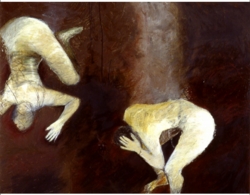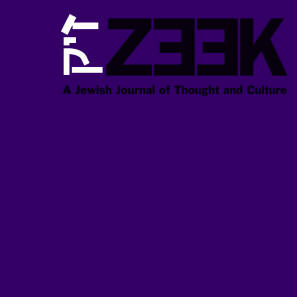 June 07
June 07
The History of "Tikkun Olam"
by Jill Jacobs
p. 2 of 2
Rabbinic Code: Sustaining the Social Order
Though the term appears earlier, “tikkun olam” only gains real currency within the Mishnah, the first attempt to codify Jewish oral law.
The term tikkun ha’olam appears in ten separate places in the Mishnah. In most of these instances, the term is employed in relation to problems in traditional divorce law. In Jewish law, a husband may divorce his wife by giving her a get (divorce document), either in person or by means of a messenger. As soon as the woman accepts this get, she is divorced and free to marry another man. There is no way for a woman unilaterally to divorce her husband.
 Both ancient and contemporary rabbis have devoted a disproportionate amount of time and energy to laws of personal status – meaning questions about who is Jewish and who is married or divorced. In the case of marriage and divorce, a primary concern is that a woman who is already married will have a child with another man. A child born of such an affair is considered to be a mamzer and is prohibited from marrying a Jew who is not also a mamzer. Though most often translated as “bastard,” the status of mamzer should be distinguished from the connotation of the English word “bastard,” which refers to a child born out of wedlock. Given the massive repercussions for a child born of an adulterous affair, the rabbis spend a great deal of time trying to ensure that there is no confusion about who is and is not married.
Both ancient and contemporary rabbis have devoted a disproportionate amount of time and energy to laws of personal status – meaning questions about who is Jewish and who is married or divorced. In the case of marriage and divorce, a primary concern is that a woman who is already married will have a child with another man. A child born of such an affair is considered to be a mamzer and is prohibited from marrying a Jew who is not also a mamzer. Though most often translated as “bastard,” the status of mamzer should be distinguished from the connotation of the English word “bastard,” which refers to a child born out of wedlock. Given the massive repercussions for a child born of an adulterous affair, the rabbis spend a great deal of time trying to ensure that there is no confusion about who is and is not married.
As the Mishnah tells it, men tend to change their minds about whether to divorce their wives. In a number of cases, the rabbis combat this male fickleness by closing legal loopholes “for the sake of tikkun ha’olam.” For example:
At first, a man [who had already sent his wife a get by means of a messenger] would set up a beit din (court) in a different place [from where the wife lived] and cancel the get. Rabban Gamliel the elder established (hitkin) that this should not be done, for the sake of tikkun ha’olam. (Mishnah Gittin 4:2)
In this example, a man sends his wife a get, changes his mind about the divorce, and sets up a legal court to annul the get. Soon afterwards, the woman receives the getand, not knowing that this gethas already been cancelled, marries again. The children of this second marriage are considered mamzerim, and therefore unfit to marry anyone who is not also a mamzer. Alternatively, a legally-savvy woman might receive a get, recognize the possibility that this get might already have been cancelled, and refrain from marrying even though she is legally permitted to do so. Given the rabbinic emphasis on the obligation to marry and procreate, this latter possibility also causes serious discomfort. Rabban Gamliel therefore decrees that a man may no longer cancel a get by means of a beit din, lest confusion over the status of gittin lead to widespread unintentional adultery or fear of remarriage.
In this case, the term mipnei tikkun ha’olam – for the sake of the repair of the world – justifies forbidding a practice that, while technically legal, threatens to disrupt the system as a whole. There are several other similar cases in the Mishnah, including one in which, for the sake of tikkun ha’olam, a woman is allowed more to easily collect on her ketubah, which specifies the money and property that she brought into the marriage, (Mishnah Gittin 4:3), and another in which a man indentured to two masters is freed as soon as he has paid off one of the masters, in order that he can avoid the in-between status of being half free and half enslaved (4:5). There is even one case in which Rabbi Hillel offers a technical workaround to an explicit law in the Torah requiring Jews to make loans in the year leading up to the sh’mitta, or sabbatical year, when all debts are forgiven (Mishnah Sh’vi’it 10:3).
In all of these mishnaic cases, we might translate “mipnei tikkun ha’olam” as “for the sake of the preservation of the system as a whole.” Within the Mishnah, this phrase is invoked in response to situations in which a particular legal detail threatens to overturn an entire system. That is: gittin of uncertain status may lead to adulterous marriages or to unnecessary celibacy; allowing individuals to be half free and half enslaved will prevent some people from fulfilling the biblical mandate to marry and procreate; and ignoring the inherent challenges of debt-forgiveness may lead to a wholesale disregard for the institution of sh’mitta. By invoking the concept of tikkun ha’olam, the rabbis fix the flaw that endangers the stability of the system as a whole.
Preserving the current social order might sound like a politically conservative move. It is worth noting, however, that the majority of these rabbinic cases involve the protection of a person or set of people who typically found themselves toward the bottom of the social order. Hillel’s loan workaround primarily benefited the poor, whose survival depended on loans from the wealthy; forcing a master to free a half-slave allowed this slave to reenter society as a free (albeit deeply in debt) person able to start a family of his own; and clarifying a woman’s marital status permitted her to remarry and therefore to guarantee her own sustenance. These “tikkun ha’olam” fixes all ensure that those who are most vulnerable are able to live full lives, rather than be restrained by a system that favors the more powerful.
Lurianic Kabbalah: Restoring Divine Perfection
The most well-known use of the term tikkun olam comes from Lurianic Kabbalah, a sixteenth-century mystical school that revolved around Rabbi Isaac Luria. Luria described creation as a process by which God contracted the divine self in order to make room for the world. In the Lurianic creation story, God then emanated Godself into the world through ten sefirot – aspects of the divine presence. God contained these sefirot within vessels, but some of the vessels proved too weak to hold the more powerful of the sefirot . The vessels shattered, resulting in the mixture of divine light with the kelipot, or shells of the vessels themselves. This process resulted in the introduction of evil into the world.
Lurianic Kabbalah imagines that Adam, the first human being, could have redeemed the world and restored the divine light to its proper place. Through his sin, however, Adam lost the chance to achieve this repair, and the responsibility for restoring divine perfection fell to later generations. The attempt to free the divine emanation from the kelipot is knows as tikkun (repair) and is achieved primarily through the performance of mitzvot (religious commandments), as well as through contemplation and study. Before performing mitzvot, the 16th century kabbalists often recited kavvanot (intentions) in which they stated their intention that this mitzvah would help to reunify parts of the divine being. The kabbalists also instituted certain new rituals, including the practice of praying or studying at midnight, and a seder for the holiday of Tu B’shevat, all intended to advance the process of tikkun.
The mystical notion of tikkun introduces into Jewish thought the idea that human actions can have an effect on the cosmos. Earlier biblical and rabbinic writings suggest that God demands certain behaviors, that human beings are rewarded or punished according to their behaviors, and even that God celebrates or mourns the appropriate or inappropriate actions of human beings. The innovation of kabbalah was the idea that God is not static, but changes in response to human behavior. In deciding whether or not to perform a mitzvah, Jews thus must consider not only the potential consequences for themselves and their communities, but also the effect that a given action may have on the cosmos.
Given the current popular understanding of “tikkun olam” as describing ethical actions, it is important to emphasize the connection, within Lurianic Kabbalah, between tikkun and halakhah (Jewish law). It is no accident that Rabbi Joseph Caro, one of the key figures in the Lurianic circle, was the author not only of significant mystical texts, but also of the Shulhan Arukh, which became the most influential code of Jewish law. If the tikkun of the cosmos would result, in part, from precise adherence to halakhah, then an accurate guide to legal practice became even more necessary than ever.
One challenge of applying the kabbalistic notion of tikkun to contemporary ethical behavior emerges from the ambivalence among mystics about what the world will look like once tikkun has been achieved. Given the focus on reuniting the divine self, it is not clear from mystical texts what, if any, place human beings will have in the perfected universe. Even while advocating the practice of ethical commandments, such as tzedakah (gifts to the poor), the kabbalists maintained a focus on the effect of individual behavior on God. Lawrence Fine in Physician of the Soul explains:
Although there is reference [in Lurianic text] to the actual giving of charity, and we have seen that Luria himself was meticulous about this obligation, the focus of contemplative attention is devoted entirely to its theurgical consequences. As individuals who were encouraged to be ethically sensitive – in conformity with rabbinic values – the Lurianic kabbalists doubtlessly believed in the intrinsic significance of tsedaqah. But the unmistakable inference one draws is that such mundane concerns were only the external dimension of deeper mystical goals. And yet, of course, the latter could not be satisfied except by means of the actual physical act – accompanied by the appropriate meditative intentions.
The brilliance of the Lurianic model of tikkun is the suggestion that human behavior can have an effect – positive or negative – on the world as a whole. mitzvot, both ethical and ritual, have an impact even beyond the immediate effect of the action. At the same time, the emphasis on realizing divine perfection, rather than on improving the condition of humanity, complicates the application of the mystical concept of tikkun to contemporary social justice work.
A New Definition of tikkun olam
The term tikkun olam more or less disappeared from popular usage between the sixteenth century and the 1950s, when the concept reemerged as the new shorthand for “social justice.” The term gained currency in the 1970s and 1980s, as the progressive Jewish world began to emerge as an entity separate from the so-called “mainstream” organizational world. The New Jewish Agenda, a 1980s attempt to create an alternative Jewish voice, used the term tikkun as a rallying cry, as do contemporary local Jewish social justice organizations such as the Progressive Jewish Alliance in California and Jews United for Justice in Washington, DC. The term has gained traction in general American liberal circles through the magazine tikkun, a left-leaning publication founded in 1986.
As noted, however, I in its current incarnation, tikkun olam can refer to anything from a direct service project such as working in a soup kitchen or shelter, to political action, to philanthropy. While once regarded as the property of the left, the term is now widely used by mainstream groups such as synagogues, camps, schools, and federations, as well as by more rightwing groups wishing to cast their own political agendas within the framework of tikkun olam.
Some have suggested imposing a ban or hiatus on the term tikkun olam, given the general confusion about the meaning of this phrase. It is hard to ignore, though, the tremendous staying power of this word as shorthand for any social change or service work. Enough people – both inside and outside of the Jewish community – find the term tikkun olam extraordinarily compelling, even more so than other Hebrew terms such as tzedek or g’milut chasadim, which have not gained the same traction in the general discourse. The popularity of the term tikkun olam, and the general emphasis on its Lurianic, rather than rabbinic, roots may indicate a desire to place one’s own work in a larger context of influencing the greater world. In an individual’s search for the meaning of his or her own life, it may be more compelling to think of one’s every action as contributing to the repair of the cosmos, than to think of the same actions as simply accomplishing a small fix to a much larger problem.
Rather than reject the term altogether as meaningless, I suggest a re-imagining of tikkun olam that combines the four understandings of the term that we have seen in traditional text: 1) the Aleynu’s concept of tikkun as the destruction of any impurities that impede the full manifestation of the divine presence; 2) the literalist midrashic understanding of tikkun olam as the establishment of a sustainable world; 3) the rabbinic willingness to invoke tikkun ha’olam as a justification for changing untenable laws; and 4) the Lurianic belief that individual actions can affect the fate of the world as a whole.
• From the Aleynu conception, our understanding of tikkun olam will include an emphasis on the elimination of evil and the restoration of the world to a perfected divine state.
• The midrashic emphasis on the physical maintenance of creation reminds us of the need to work to preserve the world at a time when human behavior is having a negative impact on global temperatures, hurricane systems, and other natural phenomena.
• The rabbinic understanding of tikkun ha’olam as the creation of a workable social and religious system leads to a definition of tikkun olam as a mandate to correct the systems that make our own society dysfunctional.
• Finally, the Lurianic belief that individual actions can have a permanent effect on the cosmos offers hope that our efforts toward tikkun will succeed.
These four strands, though complementary in some ways, also remain in tension with one another in some other important ways. The Aleynu prayer has the potential to direct Jews toward an inward focus on connecting with God and on spreading divinity through less tangible means, such as prayer or basic kindness, rather than through attention to more concrete human needs. The midrashic focus on the physical maintenance of the world might lead to an emphasis only on issues that affect the physical world – such as global warming, deforestation, or the extinction of animal species—and a concurrent disregard for human problems, such as poverty and health concerns. The rabbinic attention to fixing loopholes that disrupt the legal and social system may limit the definition of tikkun olam to issues that are understood to interfere with the large-scale functioning of society to the exclusion of issues that primarily affect a certain segment of the population. The Lurianic emphasis on the restoration of divine wholeness easily leads to an otherworldly focus, and a minimization of one’s sense of obligation toward the here and now.
By combining the major themes of these four strands, we come to a definition of tikkun olam as the process of fixing large societal problems, while maintaining a belief that our actions can have a positive effect on the greater human and divine world. When I think about my own tikkun olam commitments, I ask myself whether the work I am doing makes our society, as a whole function in a more positive way; whether the work allows even the most vulnerable members of society to live fully realized lives; and whether the work contributes to establishing a world in which the divine presence is more readily apparent. If we each ask these questions of ourselves, we can help to ensure that our work is worthy of being deemed tikkun olam.
Rabbi Jill Jacobs is the Director of Education for the Jewish Funds for Justice (JFSJ), a national public foundation dedicated to mobilizing the resources of American Jews to combat the root causes of domestic social and economic injustice. She received rabbinic ordination and an MA in Talmud and Rabbinics from the Jewish Theological Seminary, where she was a Wexner Fellow. Her writings have appeared in a number of magazines, journals, and websites, including Conservative Judaism, Tikkun, The Reconstructionist, Lilith, the Forward, Women in Judaism: A Multidisciplinary Journal, and MyJewishLearning.com. She is also a frequent contributor to jspot, a Jewish blog dedicated to domestic social and economic justice issues.









